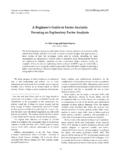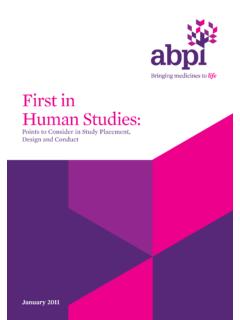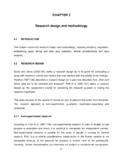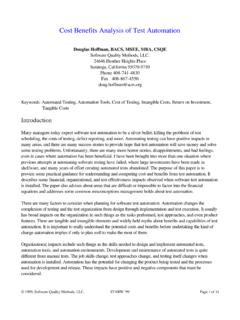Transcription of The Investigational New Drug (IND) and New Drug ...
1 The Investigational New drug (IND) and New drug Application (NDA) ProcessSusan Honig, MDDivision of Oncology drug ProductsUS Food & drug AdministrationPublic DomainRelevant Laws Federal Food, drug , and Cosmetic Act Public Health Service Act--Part F Licensing of Biological Products and Clinical LaboratoriesRelevant Regulations IND regulations (both drugs and biologics) 21 CFR 312 NDA (drugs) regulations--21 CFR 314 Product licensing (biologics)--21 CFR 601 Protection of human subjects and informed consent regulations--21 CFR 50 IRB regulations--21 CFR 56 Basis for NDA Approval Demonstration of efficacy with acceptable safety in adequate and well-controlled studies Ability to generate product labeling that Defines an appropriate patient population for treatment with the drug Provides adequate information to enable safe and effective use of the drugBasis of BLA Approval License granted for products that meet standards designed to insure continued safety, purity, and potency of the product Potency interpreted as efficacy 42 USC section 26221 CFR (s)
2 The label is the driverThe IND and NDA Process drug Development Preclinical Phases I, II, III Plan with the indication/market in mind FDA interactions Communication Meetings Submissions All aspects considered simultaneouslyPre-IND Meeting Problems with drug substance, drug product, or formulation intended for human use Questions regarding the adequacy of preclinical toxicology studies PK issues, related to dosing schedules, known/unidentified metabolites Novel dose-escalation scheme is proposed Questions regarding clinical monitoring for an anticipated end organ toxicityDrug Development TimelineIND ReviewClinicalStartAnnual reportsEnd of Phase IMeetingEnd of Phase IIMeetingIND AmendmentsPre-NDAM eetingNDA SubmissionINDS ubmission30 daysClinicalholdPhase IPhase IIPhase IIIR equirements for a New IND: Chemistry/Manufacturing Data Sufficient to assure identification, quality, and strength of the drug Impurities, sterility Product consistencyRequirements for a New IND.
3 Pharmacology/Toxicology Data Acute toxicity data from studies conducted in 2 species Generally, life-threatening toxicity in rodents Study in non-rodents (dog) that confirm dose tolerability Histopathology in at least 1 species Results sufficient to determine the starting dose for clinical studiesRequirements for a New IND: Pharmacology/Toxicology Data Conduct pharmacokinetic and toxicity studies using the same schedule, duration, formulation, and route as proposed clinical trialRequirements for a New IND: Pharmacology/Toxicology Data Number and length of studies will vary depending on: Whether you plan a single dose study or a repetitive dose study The schedule of administration (intermittent versus daily x 1 year) Population to be studied: normal volunteers vs.
4 Patients with serious and life-threatening diseaseStarting Dose for Non-oncology Drugs One-tenth the No Observed Adverse Effect Level (NOAEL) in most appropriate species on a mg/m2 basis Most appropriate = most sensitive Increase the safety factor for Steep dose-response curve Severe toxicities or irreversible toxicities Non-monitorable toxicities Toxicities without a prodrome Variable bioavailability; dose, AUC variability Unexplained mortalityStarting Dose for Oncology Drugs One-tenth the severely toxic dose to 10% of the rodents (STD10 ) on a mg/m2 basis unless 1/10 STD10 causes severe, irreversible toxicity in non-rodents, or the rodent is an inappropriate model, then One-sixth the highest non-STD in non- rodents IND Review 30-day review clock Clinical hold Safety concerns (known risk, inadequate information, IB misleading, PI not qualified)
5 Design will not allow protocol objectives to be met Requires teleconference with sponsor and division director Specific communication about what is required to lift the holdPhase I Clinical Trials (Non-cancer Drugs) Determination of : Safety, toxicity Dose range appropriate for further studies NOT maximal tolerated dose Generally conducted in normal volunteersPhase I Clinical Trials (Anticancer Drugs) Determination of : Safety Toxicity Dose Range appropriate for further studies (MTD) Generally conducted in cancer patients Concerns: Number of patients treated Careful monitoring for treatment toxicities Pharmacology/Pharmacokinetic studiesPhase I Cancer Trials Novel dose-escalation schemes May use surrogate endpoints as proof of principle Not accepted as proof of efficacyPhase II Clinical Trials (Anticancer Drugs) Initial determination of possible efficacy Further evaluation of safety Further study of appropriate dose range Generally conducted in cancer patients with measurable disease Concerns: Number of patients treated Efficient determination of potential efficacy Careful monitoring for treatment toxicitiesCommunications Issues.
6 IND Milestones During Phase II: Discuss feasibility of requesting accelerated approval based on a surrogate endpoint ( , if initial results suggest that Phase II studies may indicate improved results in a life-threatening disease If there is agreement that accelerated approval may be a possibility, proposals for post-approval randomized studies may be discussed An advisory committee member usually participatesCommunications Issues: IND Milestones During Phase II: Address product/formulation issues Scale-up Linking to-be-marketed formulation with clinical trial formulationEnd-of-Phase II Meeting Discuss design of proposed randomized trials Patient eligibility criteria Primary and secondary efficacy endpoints Sample size considerations/accrual concerns Specific safety issues/special populations Advisory committee member participates Patient advocate participates [Determine safety of proceeding to Phase III] [Address product/formulation issues]Some comments about clinical trial choice of endpoint will depend on.)
7 Therapeutic area Oncology versus non-cancer indication Type of cancer Patient population Metastatic disease First-line Refractory or no effective therapy Adjuvant Chemoprotection Chemoprevention The choice of endpoint will depend on: Traditional approval or accelerated approval Traditional approval: Clinical benefit Accelerated approval: Surrogate endpoint S< disease Better than standard therapyClinical benefit vs. Biologic activity Full approval requires demonstration of clinical benefit Traditional endpoint, such as survival Surrogate endpoint (RR) plus symptom relief Magnitude of benefit must outweigh the risks Accelerated approval: surrogate endpoint Reasonably likely to predict benefit Evidence of biologic activity (RR) sufficient Requires subsequent confirmation of benefitBiologic activity vs.
8 Clinical benefit Full approval requires demonstration of clinical benefit Traditional endpoint, such as survival Surrogate endpoint, such as RR, plus symptom relief Magnitude of benefit must outweigh the risks Accelerated approval uses a surrogate endpoint Requires subsequent confirmation of benefit If no confirmation, accelerated withdrawal The choice of endpoint will depend on: The phase of the clinical trial Related to type of approval Type of agent Typical cytotoxic Relatively non-toxic (hormonal; some biologics) Consider regulatory precedentsRegulatory Approach to Trial Design Superiority or non-inferiority trial Number of trials Generally need at least two trials Particularly important with non-inferiority studies Evidence guidances If accelerated approval, start thinking about the confirmatory studyTrial design.
9 Practical points Stratify study appropriately Imbalance may bias results Post-hoc adjusted analyses or subset analyses exploratory only Consider effect of prior therapy Androgen or tamoxifen withdrawal Use the appropriate comparator Should reflect standard of care Labeled therapy or well-documented in literature Should have documented efficacyTrial Design: Practical points Detailed prospective statistical analysis plan Follow that plan when the study is completed Consider Data Safety Monitoring Board Members should not be part of the company Results should be confidential Independently evaluate for safety Independently evaluate for efficacy only if early stopping is a consideration Efficacy Endpoints: Traditional Approval Survival (gold standard) Prolongation in time to recurrence or disease-free survival (adjuvant studies) Durable complete response Palliation (objective response with reduction in tumor-related symptoms)Efficacy Endpoints.
10 Traditional or accelerated approval? Traditional approval for hormonal therapy Response rate Time to progression, with response rate Accelerated approval for cytotoxic therapy Response rateEfficacy Endpoints: Accelerated Approval Response rate Tumors Lymphomatous meningitis Hematologic response Cytogenetic response [Colonic polyps]Phase III Clinical Trials (Anticancer Drugs) Further characterization of efficacy and safety compared to control If the control has known efficacy, studies may be designed to show non-inferiority If the control is not known to be effective (or a no treatment arm is used), studies are required to show that the new drug is superiorPre-NDA Meeting Brief summary of trial results Address any major unresolved problems Identify pivotal studies for submission Di














